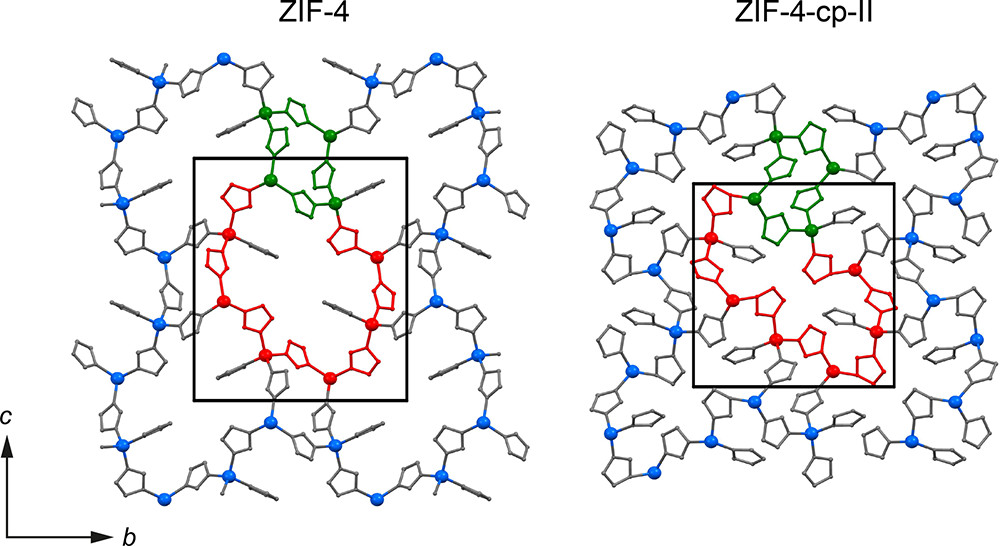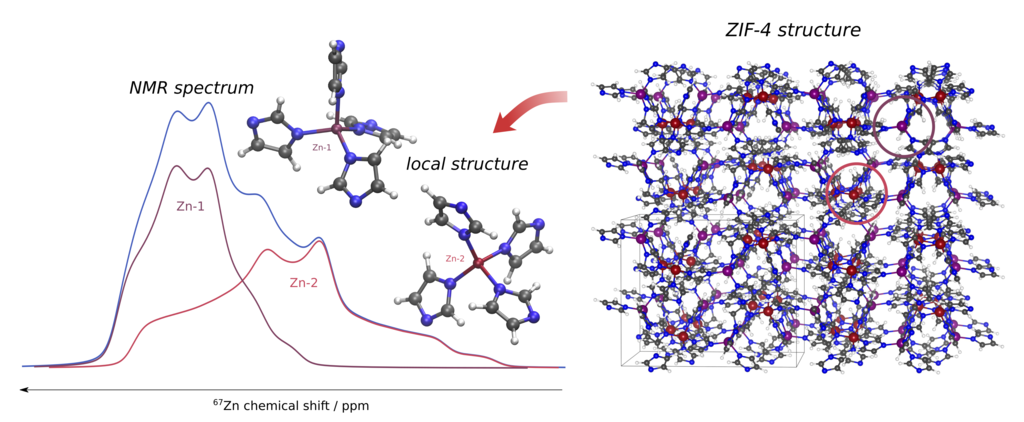Finding the needle in the amorphous haystack: Breaking the NMR spectrum of ZIF glasses
Finding the needle in the amorphous haystack: Breaking the NMR spectrum of ZIF glasses
Promotor(en): V. Van Speybroeck /28126 / Nanoporous materials, SpectroscopyBackground and problem
Thanks to their high porosity, zeolites are widely used materials, from catalysts in the chemical industry to smell absorbers in litter boxes. Zeolitic imidazolate frameworks (ZIFs) can be regarded as their modern sister materials: while exhibiting a similar degree of porosity, they are far more versatile, which enables new applications such as gas sensing. However, most ZIFs are synthesized as powders, and as such cannot be directly used in industrial settings. A workaround for this challenge is found in the rich polymorphism of ZIFs. Many ZIFs undergo solid-state transitions between different phases upon increasing temperature or pressure (Figure 1) and, in recent years, it has become clear that ZIFs can also be melted upon heating.1,2 This opens up the possibility to create ZIF glasses which can be directly used for practical applications – just as any regular glass – without having to use additives that may deteriorate the ZIF’s properties. While the possibility of ZIF liquids and glasses has been firmly confirmed experimentally, the actual atomic structure of the ZIF during this process remains a conundrum. Novel tools need to be developed that can track the ZIF’s atomic structure during these transformations, a prerequisite to rationally design new-generation framework materials.

Figure 1: Two different phases of the ZIF-4 material, showing how the structure distorts during the process. Figure reproduced from reference 2 with permission.
Nuclear magnetic resonance (NMR) is a useful technique for resolving complex structures, as the NMR response of nuclear spins to the application of external magnetic fields strongly depends on the electronic structure surrounding the nucleus. In turn, this electronic structure is determined by parameters such as bond angles and lengths and other local structural features. As a result, NMR can resolve local features even up to the single atom scale, which has recently led to the discovery of short-range disorder in ZIFs and sought-after relationships between 67Zn NMR properties and structural features.3 Quantum mechanical models are fundamental in this respect, as they can deconvolute the total NMR spectrum into NMR responses of each individual atom, using structural models as input, which means that structure-property relationships are readily derived (Figure 2). However, at this point, no systematic NMR investigation on the structure of ZIF liquids and glasses has been performed yet, hampering the development of functional structure-property relationships.

Figure 2: Large structural model of ZIF-4, from which two zinc-based clusters are extracted with different local features. These local features give rise to distinct chemical shifts, explaining the multimodal total NMR spectrum and allowing one to establish structure-spectrum and eventually structure-property relationships.
Goal
In this thesis we aim to investigate the computational NMR properties for a range of ZIFs, including ZIF-4, ZIF-7, and ZIF-8, and create a large high-standard computational dataset of ZIF NMR fingerprints. In a first step, the structure of these materials will be followed during heating and pressurization using dynamic quantum mechanical simulations. From these simulations, finite clusters will be extracted surrounding the NMR-active nucleus. Phase transformations such as melting can be described on an atomistic level and structural features that change during the melting can be characterized by 13C and 67Zn NMR,3,4 as bond features and even coordination numbers change during this transition.
Second, these finite clusters will be used to determine the chemical shift of the nucleus, and, if relevant, its asymmetry parameter and quadrupole moment. These dynamic simulations go beyond the state of the art today, but are crucial to account for the motion of the different atoms and allow for a thorough comparison with experiment. In this respect, it will also be necessary to perform a benchmark study to determine the impact of the level of theory as well as the potential presence of guest species on the calculated NMR properties. The resulting NMR fingerprint will then be stored together with the structure it was derived from. Finally, the generated dataset will be analyzed with the aim of discovering trends in the resonances, which can be used to guide and interpret future experimental studies as plausible structures with matching local structural features/NMR properties can be identified based on experimental input. As such, our database can be adopted to characterize the local structure in the experimental sample at hand.
If time permits, even larger structural ZIF models – which contain a more diverse set of structural disorder during the phase transitions – can be created. As these models prohibit the direct use of quantum mechanical simulation codes, available force fields developed at the CMM will be used to track their structure under heating and pressurization, after which the same workflow as sketched above can be used to further expand the NMR fingerprint database.
- Study programmeMaster of Science in Engineering Physics [EMPHYS], Master of Science in Physics and Astronomy [CMFYST]Keywordsmelting, structure-property relationships, phase transformations, zeolitic imidazolate frameworks, glassesReferences
1J.M. Tuffnell, C.W. Ashling, J. Hou, S. Li, L. Longley, M.L. Ríos Gómez, T.D. Bennett, Chem Commun. 55: 8705, 2019.
2R.N. Widmer, G.I. Lamproni, S. Chibani, C.W. Wilson, S. Anzellini, S. Farsang, A.K. Kleppe, N.P.M. Casati, S.G. MacLeod, S.A.T. Redfern, F.-X. Coudert, T.D. Bennett, J. Am. Chem. Soc. 141: 9330, 2019.
3R.S.K. Madsen, A. Qiao, J. Sen, I. Hung, K. Chen, Z. Gan, S. Sen, Y. Yue, Science 367: 1473, 2020.
4V. Nozari, C. Calahoo, J.M. Tuffnell, D.A. Keen, T.D. Bennett, L. Wondraczek, Nat. Commun. 12: 5703, 2021.
